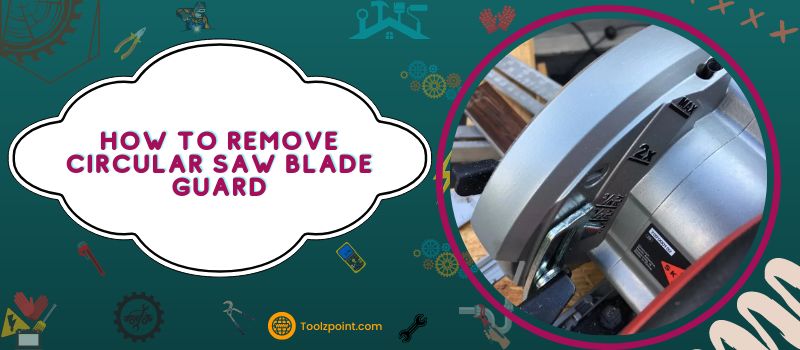A circular saw blade guard’s task is well-intended. A blade guard keeps the blade safe and covered when the blade is not active, or you have to store it somewhere. But did you know you can remove it too?
There is a release button or lever that can detach and attach the blade guard. But practically the procedure is a little more complicated. Moreover, you have to prioritize the safety of yourself and the circular saw.
Curious to learn how to remove the circular saw blade guard and where to find that lever to remove it? Well, keep reading to find out all in here.

How To Remove Circular Saw Blade Guard?
Removing a blade guard on a circular saw depends on the model’s manufacturing process and varies from model to model. However, there might be slight changes in the parts and components, but the general steps are all similar in every circular saw. So, let’s keep the discussion general and see how you can remove the blade guard.
1. Unplug The Circular Saw
First, take the electrical cord away from the outlet. Merely switching off the switch won’t suffice here. Make sure the circular saw is totally away from any electrical connection. Any spark or power can cause an accident or injury.
If the circular saw is cordless, make sure the battery is taken down. If the cordless circular saw is power-based, the charge should be at its lowest. After detaching the saw from power, try to run the circular saw to ensure it doesn’t move or work.
2. Locate The Blade Guard
The blade guard is the cover that surrounds the blade when the blade is not in use. It is not hard to locate a blade guard, but it is challenging to locate the starting point of the guard. Usually, the blade guard is made of plastic or metal.
3. Search For The Release Lever Or Button
The release lever or button on the blade guard is the starting point where the guard is attached to the body of the circular saw. If the follow the line of the blade guard you can locate the lever. This lever or button is generally situated on the back of the guard. If it is hard to find, locate the pivot point first and look for the lever near that.
4. Press On The Release Lever Or Button
Once you located the lever, press the button with your thumb and hold it in place. If your finger can’t press the lever hard enough you can use the bottom part of the pencil or a thin scrap of wood to press the lever hard.
5. Lift The Blade Guard Up
While pressing the lever or button, safely lift the blade guard with another hand and slowly take that away from the blade. If you are not comfortable with both pressing the lever and lifting the blade guard, you can ask for someone’s help to do either of the jobs. However, make sure that both of your hands are safe and comfortable.
6. Reinstalling
Now that the blade guard of the circular saw is removed, you can access the blade for maintenance or replace the blade guard. Once you are done with the task, you can simply reverse the instructions and reinstall the blade guard.
When Should I Remove The Blade Guard?
Removing a circular saw blade guard can impose lots of hazard issues for you. So, you shouldn’t remove the blade guard without any valid cause and reason. However, there are certain times when you must remove it. Let’s see the potential reasons for removing a blade guard from a circular saw.
1. To Make Specific Cuts
Sometimes, in specific cuts, the blade guard is in the way and hinders the process of a swift and efficient cut. Especially in bevel cuts and resawing timber, the blade guard sometimes makes the cut rough and edgy. In that case, you can remove the guard but be extra careful while using the blade.
2. When The Saw Needs Some Maintenance
If the saw or the blade needs to go through some maintenance for some internal issues like broken components, a dent on the blade or the saw is not just working, you have to remove the guard blade. In case the circular saw is acting weird, you should probably leave the circular saw in the care of a professional.
3. Material To Be Cut Is Too Thick
When the material is too thick, you have to expose the full potential of the blade. That means, to run the blade at the deepest depth, the blade guard of the circular saw has to be gone. Also, if the blade requires to penetrate from the side like in plunge cuts, it is better to remove the blade guard.
4. To Change The Saw Blade
A circular saw has tons of different blades, and you need to use a proper blade on a particular material. So, while shifting blades, you have to remove the blade guard first. Without removing the guard, you can’t attach the blade to the nut that holds the blade.
5. Cleaning The Blade And Saw
In repetitive use over time, the circular saw can amass lots of debris and detritus. Also, the sawdust can seem harmless at the beginning. But over time, it would plunge upon the components inside the circular saw. So, when you have to clean the saw from the core, you have to remove the blade guard to reach the core.
6. Adjusting The Saw Depth
When you have to adjust the saw blade depth or bevel, you may need to remove the guard. This doesn’t apply to every model but some of them can have that design. To access the adjustment panel, you might have to get through the blade guard.
7. Repairing And Replacing
Well, it is a no-brainer that you have to remove the blade guard to repair or replace the blade guard. However, in case the repair has to be done on the motor, the way to the motor can be hindered by a blade guard. So, for this reason, you may have to remove the blade guard.
Some Tips To Remember

- Wear proper protecting gear. Especially don’t ignore the hand gloves. You should also wear safety goggles to deter any flying debris.
- Before attempting to remove the blade guard, carefully examine the manufacturer’s instructions. If you have any questions about how to proceed safely, seek advice from a qualified specialist.
- To make sure the blade doesn’t move when you are removing the blade guard, you can use the blade removal tool or similar devices.
- Keep your arms and face away from the circular saw. We often get too busy protecting our fingers and wrists while ignoring our arms and face.
- Once the blade guard has been taken off, use extra caution to prevent coming into contact with the saw blade, and make sure to put it back on as soon as the job is finished.
People Also Ask

Why you shouldn’t remove the blade guard unnecessarily?
Removing circular saw blade guards is a highly dangerous task ever for a professional. There can be flying debris that can hurt your body and the blade which may accidentally cut your skin. Also, without the blade guard, the cuts will be less accurate. Without it, the kickbacks will increase, and the performance of the saw will never be the same.
Can I modify the blade guard to make it more user-friendly?
You may modify the blade guard. However, this depends on the manufacturer’s design. Some models have such rigid designs that you can’t even consider altering them. But most circular saws have some limited and moderate options to modify the blade guard to make you more comfortable with the circular saw.
How to prevent removing the blade guard more often?
It is wise not to remove the blade guard repeatedly unless it is absolutely necessary. Luckily, following some easy tips, you can keep the guard blade safe and deter from removing it so often. For example, don’t let any sawdust and debris hang inside it. Adjust it as it can be comfier and safer.
Final Words
You should prevent yourself from removing the circular saw blade guard as much as you can. But sometimes, it becomes an absolute necessity. So, when you have to remove it follow the above mentioned procedure and never forget to prioritize safety.
